
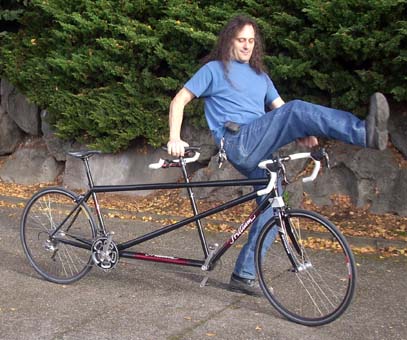
We suggest the captain mount the bike first. It might even be easiest to swing one leg over the handlebars. It may sound awkward but after you do it a few times, you may find it is actually very easy. The reason we suggest this, is that if you mount in the common method of lifting your leg over the saddle, you may find that you'll catch it on the stoker's bars, or accidentally kick the stoker. However you do it, the captain gets on first.

The Captain then holds the brakes tight and takes a little wider stance than on a single. Wide enough, that when the stoker turns the pedals, you are not going to get hit by them. The stoker then gets on and mounts their feet into the pedals. The stoker is going to stay with their feet on the pedals at all future stops.
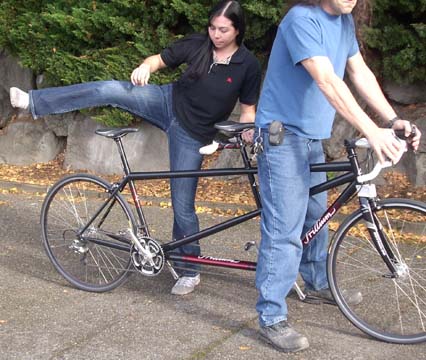
Not the Stoker gets on the bike. It's important that the Captain keep holding the brakes so the bike remains as stable as possible. Keep a wide stance at this point too, as the stoker may need to rotate the pedals while getting on the bike (you don't want to get hit in the shins).
The bike might feel a bit wobbly as the Stoker gets on, but as long as you're holding the brakes and keeping the bars stable it shouldn't fall over.
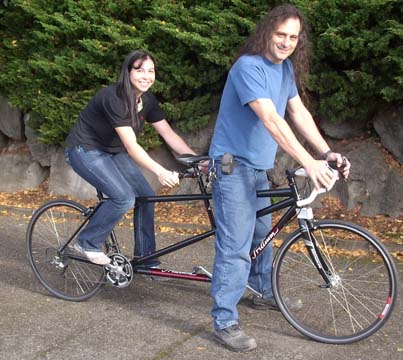
Now the Stoker is completely on the bike and both feet are clipped into the toe clips or other pedals. At this point I usually ask the Stoker to rotate the pedals until the cranks are positioned with the Captain's dominant side pedal is all the way at the bottom.
Stoker will stay in the pedals at all stop signs and stop lights along the ride. The Captain will balance the bike when it's stopped.
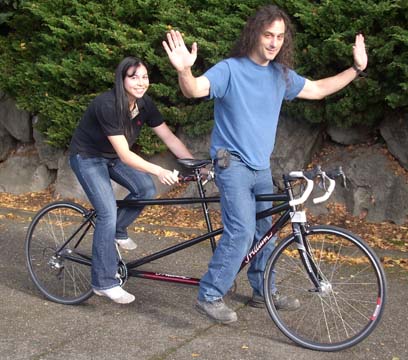
With the dominant pedal down, Captain can now clip into the pedal. In this photo I am using my hip to hold the seat and my leg to hold the top tube. With my right foot clipped in, I can easily balance the bike with just one foot on the ground, even with no hands on the bars or brakes. There is no need for the Stoker to put a foot down at a stop. If they do, it often causes confusion when you're trying to start again.
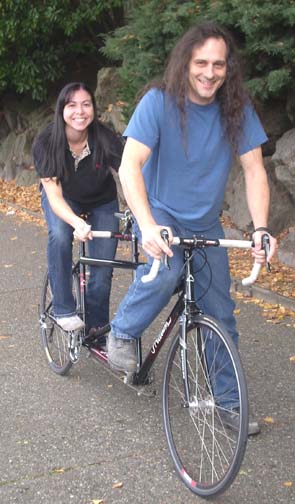
While still stabilizing the bike with my hip and my leg, I can now grab the brakes again while we rotate the pedals backwards until the "stroke foot" (or dominant foot) is at our starting point (in my case about 2 o'clock).
This is also how you want to be at a stop sign or intersection. Once you've come to a stop, the Captain will put one foot on the ground and stabilize the bike using their hip, leg and brakes while the Stoker stays in their pedals. Remember to rotate your "stroke foot" to your starting point before the light turns green.
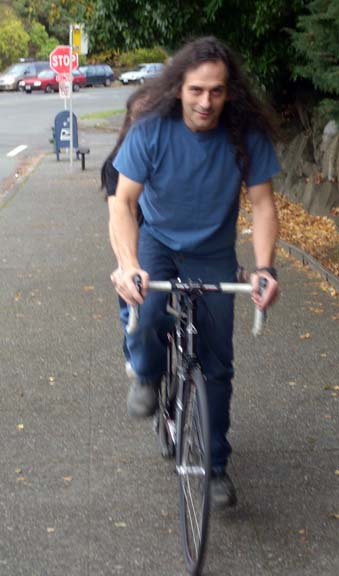
The captain gives a verbal clue ("ready, set, go" or whatever you choose) and both people power the "stroke foot". At this point the Captain basically stands up on the power foot and hoists themselves onto the saddle, not worrying about the second stroke. The Stoker has lots of power.
Warning: The captain wants to be sure not to push off two or three times with the ground foot.Once the first power is applied the stoker is continuing to turn the pedals and if the captain has a foot on the ground at the beginning of the second stroke...it isn't easy or pretty.
Now you have both riders on the bike and the pedals turning. The Captain can wait a few revolutions before getting into toe clips or clipless pedals if it takes some concentration or coasting. It is best to get thru an intersection or get up some speed and then coast for a second while you adjust anything you need to.
Stopping:
When you stop a tandem you need to keep in mind that you have twice the weight of a single and the momentum is usually greater. The captain should wait until the bike is nearly at a complete stop before putting down a foot. It is imperative to be consistent with which foot is going down first. The stoker will lean to counterbalance the bike and this happens quickly and instinctively. Once you establish the habit of a particular foot, it is necessary to stick to it. Once the bike is stopped and one foot is on the ground, again the captain takes a little bit of a wider stance, leans the bike into a hip and holds a brake. It is best to rotate the pedals, setting the power foot in the up position to start the bike.






